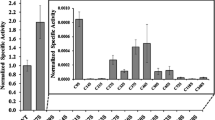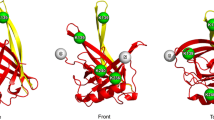Abstract
The activity of violaxanthin de-epoxidase has been studied both in isolated thylakoids and after partial purification, as a function of pH and ascorbate concentration. We demonstrate that violaxanthin de-epoxidase has a Km for ascorbate that is strongly dependent on pH, with values of 10, 2.5, 1.0 and 0.3 mM at pH 6.0, 5.5, 5.0 and 4.5, respectively. These values can be expressed as a single Km±0.1±0.02 mM for the acid form of ascorbate. Release of the protein from the thylakoids by sonication was also found to be strongly pH dependent with a cooperativity of 4 with respect to protons and with an inflexion point at pH 6.7. These results can explain some of the discrepancies reported in the literature and provide a more consistent view of zeaxanthin formation in vivo.
Similar content being viewed by others
References
Adams WW, Demmig-Adams B, Verhoeven AS and Barker DH (1994) Photoinhibition during winter stress: Involvement of sustained xanthophyll cycle-dependent energy dissipation. Aust J Plant Physiol 22: 261–276
Björkman O and Demmig-Adams B (1994) Regulation of photosynthetic light energy capture, conversion, and dissipation in leaves of higher plants. In: Schulze E-D and Caldwell MM (eds) Ecophisiology of Photosynthesis, pp 17–47. Springer-Verlag, Berlin
Bolliger HR and König A (1969) Vitamins, including carotenoids, chlorophylls and biologically active quinones. In: Stahl E (ed) Thin-layer Chromatography, pp 259–311. Springer-Verlag, Berlin
Briantais J-M, Vernotte C, Picaud M and Krause GH (1979) A quantitative study of the slow decline of chlorophyll a fluorescence in isolated chloroplasts. Biochim Biophys Acta 548: 128–138
Demmig-Adams B, Adams WW, Logan BA and Verhoeven AS (1995) Xanthophyll cycle-dependent energy dissipation and flexible Photosystem II efficiency in plant acclimated to light stress. Aust J Plant Physiol 22: 249–260
Demmig-Adams B, Winter K, Krüger A and Czygan F-C (1989) Zeaxanthin and the induction and relaxation kinetics of the dissipation of excess excitation energy in leaves in 2% O2, 0% CO2. Plant Physiol 90: 887–893
Demmig B, Winter K, Krüger A and Czygan F-C (1987) Photoinhibition and zeaxanthin formation in intact leaves. Plant Physiol 84: 218–224
Foyer CH (1993) Ascorbic acid. In: Alscher RG and Hess JL (eds) Antioxidantsin Higher Plants, pp 31–58. CRC Press, Ann Arbor
Frank HA, Cua A, Chynwat V, Young A, Gosztola D and Wasielewski MR (1994) Photophysics of the carotenoids associated with the xanthophyll cycle in photosynthesis. Photosynth Res 41: 389–395
Gillham DJ and Dodge AD (1986) Hydrogen-peroxide-scavenging systems within pea chloroplasts. Planta 167: 246–251
Gillham DJ and Dodge AD (1987) Chloroplast superoxide and hydrogen peroxide scavenging systems from pea leaves: Seasonal variations. Plant Sci 50: 105–109
Hager A (1969) Lichtbedingte pH-Erniedrigung in einem Chloroplasten-Kompartiment als Ursache der enzymatischen Violaxanthin-Zeaxanthin-Umwandlung; Beziehungen zur Photophosphorylierung, Planta 89: 224–243
Hager A and Holocher K (1994) Localization of the xanthophyll-cycle enzyme violaxanthin de-epoxidase within the thylakoid lumen and abolition of its mobility by a (light-dependent) pH decrease. Planta 192: 581–589
Horton P and Lee P (1985) Phosphorylation of chloroplast membrane proteins partially protects against photoinhibition. Planta 165: 37–42
Junesch U and Gräber P (1987) Influence of the redox state and the activation of the chloroplast ATP synthase on proton-transport-coupled ATP synthesis/hydrolysis. Biochim Biophys Acta 893: 275–288
Krause GH and Behrend U (1986) ΔpH-dependent chlorophyll fluorescence quenching indicating a mechanism of protection against photoinhibition of chloroplasts. FEBS Lett 200: 298–302
Laemmli UK (1970) Cleavage of structural proteins during the assembly of the head of bacteriophage T4. Nature 227: 680–685
Neubauer C and Yamamoto HY (1994) Membrane barriers and Mehler-peroxidase reaction limit the ascorbate available for violaxanthin de-epoxidase activity in intact chloroplasts. Photosynth Res 39: 137–147
Pfündel EE and Dilley RA (1993) The pH dependence of violaxanttiin deepoxidation in isolated pea chloroplasts. Plant Physiol 101: 65–71
Schöner S and Krause GH (1990) Protective systems against active oxygen species in spinach: Response to cold acclimation in excess light. Planta 180: 383–389
Stachelin LA and Arntzen CJ (1983) Regulation of chloroplast membrane function: Protein phosphorylation changes the spatial organization of membrane components. J Cell Biol 97: 1327–1337
Thayer SS and Björkman O (1990) Leaf xanthophyll content and composition in sun and shade determined by HPLC. Photosynth Res 23: 331–343
Yamamoto HY and Higashi RM (1978) Violaxanthin de-epoxidase. Arch Biochem Biophys 190: 514–522
Author information
Authors and Affiliations
Rights and permissions
About this article
Cite this article
Bratt, C.E., Arvidsson, PO., Carlsson, M. et al. Regulation of violaxanthin de-epoxidase activity by pH and ascorbate concentration. Photosynth Res 45, 169–175 (1995). https://doi.org/10.1007/BF00032588
Received:
Accepted:
Issue Date:
DOI: https://doi.org/10.1007/BF00032588




